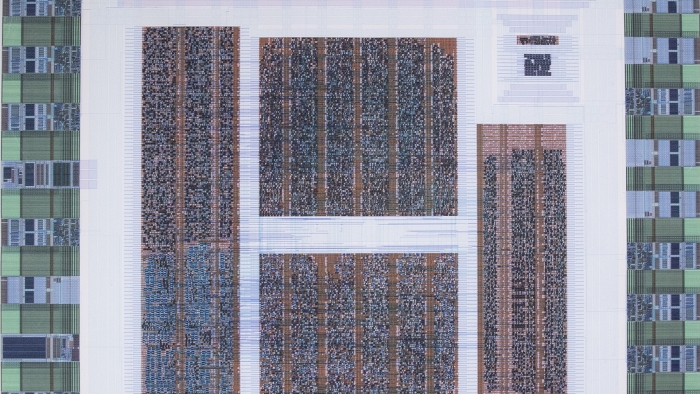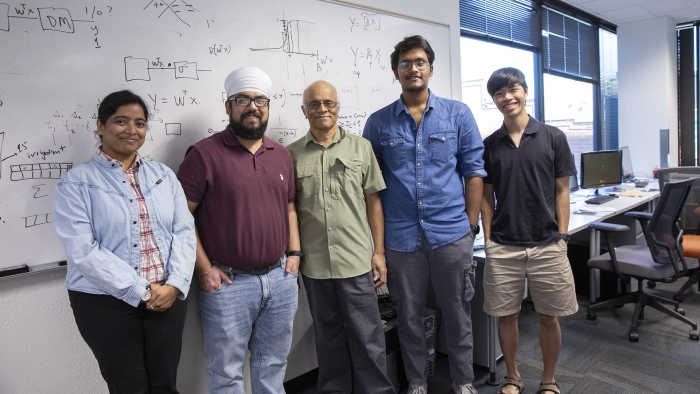How computer science can supercharge the semiconductor industry

Sarma Vrudhula is a professor of computer science and engineering in the School of Computing and Augmented Intelligence, part of the Ira A. Fulton Schools of Engineering at Arizona State University. He has been awarded a $2 million grant from the National Science Foundation to design a new chip that will be 100 times more energy efficient than current-generation technology. Photo by Erika Gronek/ASU
The advent of the era of artificial intelligence, or AI, has brought new challenges and new opportunities to the microelectronics industry.
“When it comes to making progress in AI, energy is the showstopper,” Sarma Vrudhula says. “Artificial intelligence computations take incredible amounts of electrical energy. For us to continue to advance, and for overall sustainability, we must find ways to reduce power consumption.”
Vrudhula is a professor of computer science and engineering in the School of Computing and Augmented Intelligence, part of the Ira A. Fulton Schools of Engineering at Arizona State University. He and his team have received a $2 million grant from the U.S. National Science Foundation (NSF) to design new microchips and systems to power the next phase of the AI revolution.
Vrudhula will be collaborating with Marwan Krunz, Regents Professor and Kenneth Von Behren Endowed Professor of Electrical and Computer Engineering and a professor of computer science from the University of Arizona, and Sanmukh Kuppannagari, the James C. Wyant Assistant Professor of computer and data sciences from Case Western Reserve University. Their work is part of Future of Semiconductors (FuSe2), an NSF initiative aligned with the CHIPS and Science Act of 2022, a groundbreaking collaboration between U.S. governmental agencies and industry partners to address the global microchip shortage triggered by the COVID-19 pandemic.
New ideas to power new technology
For years, microchips were designed by hand. Thanks to the work of experts in operations research and design automation, such as Vrudhula, software was developed to take over this planning. Today, engineers can feed design and performance expectations into sophisticated software programs to receive an optimized design to meet their needs.
Vrudhula’s new methodology uses complementary metal-oxide semiconductor technology. He expects the resulting design to be 100 times more energy efficient than current-generation technology, in part because AI calculations can be performed on the chip itself. Vrudhula’s design ideas have been awarded 18 patents, and the new chip is slated for use in devices on 5G and 6G cellular networks, such as mobile phones and tablets.
As Vrudhula and his team wind down their initial design process, they are preparing to fabricate numerous prototypes, seeking manufacturing options at the Southwest Advanced Prototyping Hub, or SWAP Hub, as well as with industry partners.
Software designs chips, computer scientists design software
If we will build new semiconductor manufacturing facilities, someone must be trained to work in them. As such, one key goal of the FuSe2 program is to address critical workforce shortages in the semiconductor industry.
To fill these gaps, Vrudhula knew just where to look.
“We’re going to work hard to get computer science students interested in hardware design,” he says.
The School of Computing and Augmented Intelligence has one of the nation’s largest computer science programs. The school welcomed more than 12,000 students this fall and broke graduation records at the spring Fulton Schools convocation ceremonies, where it awarded more than 1,800 degrees.
Vrudhula is creating a new course as part of the grant that will provide a link between the computer science curriculum and an understanding of chip design. Students will have access to on-campus paid internships and meetings with important figures in the semiconductor industry.
Vrudhula, who also serves as the director of the Intelligent, Distributed, Embedded Applications and Systems Center, hopes to demonstrate that computer science students searching for opportunities to create AI technology, especially in the development of deep neural networks, can have exciting and rewarding careers in microelectronics.
“Not only is Sarma Vrudhula designing an excellent piece of microelectronics, but he is also teaching students to do the same,” said Ross Maciejewski, director of the School of Computing and Augmented Intelligence. “This CHIPS-funded project honors the FuSe mission of producing new technology and training the next generation of technologists.”
More Science and technology
2 ASU faculty elected as fellows to National Academy of Inventors
Arizona State University faculty members Bertram Jacobs and Klaus Lackner have been elected as fellows to the National Academy of Inventors (NAI). Both are being honored for research that…

Harvesting satellite insights for Maui County farmers
Food sovereignty can refer to having access to culturally significant foods, but Noa Kekuewa Lincoln believes it goes farther than that.“I think the concept goes beyond the foods themselves to having…

Google grant creates AI research paths for underserved students
Top tech companies like Google say they are eager to encourage women and members of historically underrepresented groups to consider careers in computer science research.The dawn of the era of…

